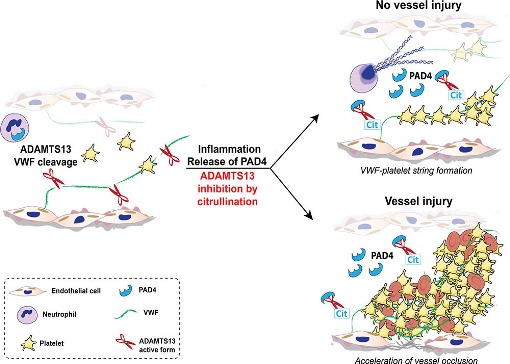Thompson Lab’s collaboration with Boston Children’s Hospital leads to a new publication in Circulation Research
Date Posted: Thursday, October 31, 2019 PAD4 (peptidylarginine deiminase type IV), an enzyme essential for neutrophil extracellular trap formation (NETosis), is released together with neutrophil extracellular traps into the extracellular milieu. It citrullinates histones and holds the potential to citrullinate other protein targets. While NETosis is implicated in thrombosis, the impact of the released PAD4 is unknown. Here we show that injection of r-huPAD4 in vivo induces the formation of VWF (von Willebrand factor)-platelet strings in mesenteric venules and that this is dependent on PAD4 enzymatic activity. VWF-platelet strings are naturally cleaved by ADAMTS13 (a disintegrin and metalloproteinase with thrombospondin type-1 motif-13). We detected a reduction of endogenous ADAMTS13 activity in the plasma of wild-type mice injected with r-huPAD4. Using mass spectrometry and in vitro studies, we found that r-huPAD4 citrullinates ADAMTS13 on specific arginine residues and that this modification dramatically inhibits ADAMTS13 enzymatic activity. Elevated citrullination of ADAMTS13 was observed in plasma samples of patients with sepsis or noninfected patients who were elderly (e.g., age >65 years) and had underlying comorbidities (e.g., diabetes mellitus and hypertension) as compared with healthy donors. This shows that ADAMTS13 is citrullinated in vivo. VWF-platelet strings that form on venules of Adamts13-/- mice were immediately cleared after injection of r-huADAMTS13, while they persisted in vessels of mice injected with citrullinated r-huADAMTS13. Next, we assessed the effect of extracellular PAD4 on platelet-plug formation after ferric chloride-induced injury of mesenteric venules. Administration of r-huPAD4 decreased time to vessel occlusion and significantly reduced thrombus embolization. Our data indicate that PAD4 in circulation reduces VWF-platelet string clearance and accelerates the formation of a stable platelet plug after vessel injury. We propose that this effect is, at least in part, due to ADAMTS13 inhibition.
PAD4 (peptidylarginine deiminase type IV), an enzyme essential for neutrophil extracellular trap formation (NETosis), is released together with neutrophil extracellular traps into the extracellular milieu. It citrullinates histones and holds the potential to citrullinate other protein targets. While NETosis is implicated in thrombosis, the impact of the released PAD4 is unknown. Here we show that injection of r-huPAD4 in vivo induces the formation of VWF (von Willebrand factor)-platelet strings in mesenteric venules and that this is dependent on PAD4 enzymatic activity. VWF-platelet strings are naturally cleaved by ADAMTS13 (a disintegrin and metalloproteinase with thrombospondin type-1 motif-13). We detected a reduction of endogenous ADAMTS13 activity in the plasma of wild-type mice injected with r-huPAD4. Using mass spectrometry and in vitro studies, we found that r-huPAD4 citrullinates ADAMTS13 on specific arginine residues and that this modification dramatically inhibits ADAMTS13 enzymatic activity. Elevated citrullination of ADAMTS13 was observed in plasma samples of patients with sepsis or noninfected patients who were elderly (e.g., age >65 years) and had underlying comorbidities (e.g., diabetes mellitus and hypertension) as compared with healthy donors. This shows that ADAMTS13 is citrullinated in vivo. VWF-platelet strings that form on venules of Adamts13-/- mice were immediately cleared after injection of r-huADAMTS13, while they persisted in vessels of mice injected with citrullinated r-huADAMTS13. Next, we assessed the effect of extracellular PAD4 on platelet-plug formation after ferric chloride-induced injury of mesenteric venules. Administration of r-huPAD4 decreased time to vessel occlusion and significantly reduced thrombus embolization. Our data indicate that PAD4 in circulation reduces VWF-platelet string clearance and accelerates the formation of a stable platelet plug after vessel injury. We propose that this effect is, at least in part, due to ADAMTS13 inhibition.
PMID: 31248335
Read the full article: https://www.ahajournals.org/doi/10.1161/CIRCRESAHA.118.314571
For more about the Thompson lab, please visit https://www.umassmed.edu/thompson
All of Dr. Thompson's publications can be viewed on myNCBI
